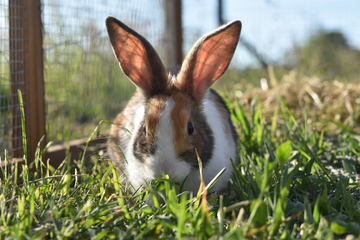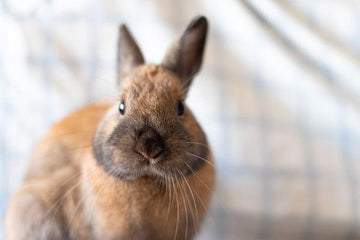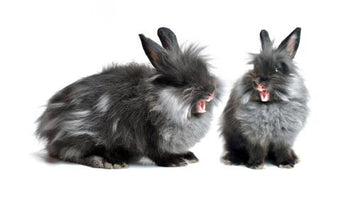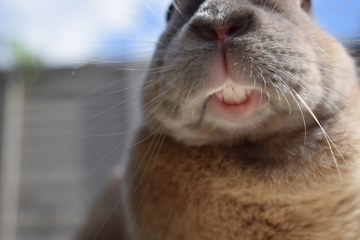How Long Do Rabbits Live? Understanding the Lifespan of Our Furry Friends
Rabbits, known for their gentle demeanor and loving personalities, hold a special place both as cherished pets and wild animals.
Click Here For a Guide to Understanding Your Rabbits Diet.
If you’re caring for a rabbit, understanding their lifespan can help you provide better care and foster a deeper connection with these wonderfully furry creatures! This blog explores the average lifespan of both domestic and wild rabbits and offers tips to help your pet rabbit enjoy a long, healthy, and happy life.

The Seven Life Processes in Rabbits
The seven life processes—movement, respiration, sensitivity, growth, reproduction, excretion, and nutrition—are fundamental characteristics shared by all living animals, including rabbits.
Movement
Movement is essential for foraging, escaping predators, and social interaction. Even newborns exhibit instinctual movements that evolve as they grow, enabling them to explore and adapt to their surroundings.
Respiration
Respiration, AKA breathing, is fundamental for energy production. The respiratory process in rabbits begins with simple breathing at birth and becomes more efficient as rabbits mature, which supports increased activity and growth.
Sensitivity
Sensitivity starts with basic responses to touch and temperature in newborn rabbits and progresses to complex sensory responses to their environment in adults. This heightened awareness helps rabbits detect food sources and avoid dangers.
Growth
Rabbits experience rapid growth in their early life stages. Proper nutrition and care during this period are vital for developing healthy body structures and ensuring overall well-being.
Reproduction
Reproductive capabilities emerge in young adults. This process allows for species continuation and influences behaviors and care needs. Understanding reproductive health is important for humans to learn so they can manage rabbit populations and individual health.
Excretion
Effective waste management is a key aspect of rabbit health. Changes in diet are reflected in their excretion patterns throughout their life. Monitoring these patterns can provide insights into their health and dietary needs.
Nutrition
Adequate nutrition is vital at every stage, from milk in newborns to a varied diet of hay, vegetables, and pellets in adults and seniors. Proper nutrition supports their growth, health, and longevity, making it a cornerstone of rabbit care.
The Lifespan of Domestic Rabbits
Domestic rabbits typically live longer than their wild counterparts due to the controlled and safe environment they are provided.
On average, pet rabbits can live anywhere from 8 to 12 years, with some breeds and individuals reaching up to 15 years or more. The lifespan of domestic rabbits can vary depending on several factors, including breed, diet, genetics, and their overall care.
Breed: Some breeds, such as the Mini Rex and Netherland Dwarf rabbits, are known for their longevity, often living 10 to 12 years or more. Larger breeds, like the Flemish Giant, tend to have shorter lifespans, generally around 5 to 7 years.
The Lifespan of Wild Rabbits
Wild rabbits face a host of challenges that often result in shorter lifespans compared to their domestic cousins. Wild rabbits typically live between 1 and 3 years. Predation, harsh weather conditions, disease, and limited food resources are significant factors that contribute to their shorter lifespan.
Survival Strategies in the Wild
Burrowing: Many wild rabbits, such as the European rabbit, live in burrows that offer protection from predators and harsh weather.
Reproductive Rates: Wild rabbits have high reproductive rates, allowing populations to remain stable despite high mortality rates. A female rabbit can give birth to multiple litters each year, each containing several kits.
Adaptability: Wild rabbits are highly adaptable and have developed keen senses and quick reflexes to evade predators and forage efficiently.
Caring for an Injured Wild Rabbit
If you encounter an injured rabbit in the wild, begin by assessing the rabbit's condition from a safe distance to understand the severity of its injuries. If you need to relocate it, wear protective gloves and gently place it in a secure, ventilated container lined with a soft cloth.
Ensure the container is kept in a quiet, warm area away from noise and disturbance. You should contact a veterinarian who has experience with wild animals to administer proper care. While awaiting professional assistance, provide a shallow dish of water; avoid feeding the rabbit.
The goal of rehabilitation is to restore the rabbit's health for eventual release back into the wild, contingent upon its recovery and adaptability. With timely intervention, many injured wild rabbits can successfully recuperate and thrive post-rehabilitation.
Comparing Domestic and Wild Rabbit Lifespans
The stark difference in lifespan between domestic and wild rabbits highlights the impact of environment and care on longevity. Domestic rabbits benefit from a controlled diet, shelter, and medical care, leading to significantly longer lives. In contrast, wild rabbits must navigate a more perilous existence, leading to a shorter average lifespan.
Maximizing Your Pet Rabbit's Lifespan
Proper Diet
A healthy diet is the cornerstone of rabbit care. Make sure your rabbit has a steady supply of fresh hay (roughly 80% of their diet should be grass hay), which helps with their digestion and dental health – both are very important aspects of rabbit healthcare.
Complement their hay with fresh vegetables and a controlled amount of high-quality pellets. Avoid sugary treats and excessive amounts of fruit. Click here for recommended daily feeding suggestions depending on the age of your pet rabbit.
Exercise and Enrichment
Rabbits are active animals that need space to hop and explore. Providing a safe area for exercise and mental stimulation helps prevent obesity and boredom. Toys, tunnels, and interaction with humans or other rabbits can keep your pet mentally and physically engaged.
Healthcare
Regular veterinary care is important for early detection and treatment of health issues. Spaying or neutering your rabbit can also prevent certain cancers and improve their overall health. Vaccinations and parasite control are essential preventive measures.
Clean and Safe Living Conditions
Maintain a clean living environment to reduce the risk of infection and stress. Ensure that your rabbit’s habitat is free from potential hazards and provides a comfortable and secure space.
Rabbit Life Cycle Stages
Rabbits go through several life stages, each with unique care requirements:
Newborn (Neonate)
Age: Birth to 2 weeks
Characteristics: Entirely dependent on the mother for warmth and nutrition. Rabbits are born blind, deaf, and without hair. Nursing occurs for only a couple of minutes throughout the day.
2-4 Weeks Old (Infant)
Age: 2 to 4 weeks
Characteristics: Rabbits start to open their eyes and discover their surroundings. They rely primarily on their mother’s milk but start to show interest in solid foods. Alfalfa Hay and pellets can be introduced, but their diet should not consist solely of these foods.
4-6 Weeks Old (Weanling)
Age: 4 to 6 weeks
Characteristics: They grow more hair, begin drinking water, and start weaning off their mother’s milk, increasing their intake of Alfalfa Hay and pellets. By six weeks, they are fully independent from their mother and can survive on their own.
3-6 Months Old (Adolescence)
Age: 3 to 6 months
Characteristics: Male rabbits reach sexual maturity at 3-4 months, and females at 5-6 months. Spaying or neutering during this period helps manage behaviors like urine spraying in males and territorial aggression in females.
6 Months-1 Year Old (Teenagers)
Age: 6 months to 1 year
Characteristics: Transition to Timothy Hay is recommended around 7 months, and Alfalfa Hay should be limited. Rabbits reach full maturity and might exhibit increased moodiness, similar to teenagers figuring out their social dynamics.
1-3 Years Old (Young Adult)
Age: 1 to 3 years
Characteristics: Rabbits are fully mature, often energetic, and spend a lot of time exercising and exploring. Rabbit-proofing your home is essential to keep them safe during this active phase.
3-5 Years Old (Middle Age)
Age: 3 to 5 years
Characteristics: Rabbits may become less active and more affectionate, showing increased trust and attachment to their owners.
5-7 Years Old (Late Middle Age)
Age: 5 to 7 years
Characteristics: It’s common to notice your rabbit having difficulty keeping themselves clean. Regular veterinary visits become more important to ensure continued health and well-being.
7 Years Old and Above (Old Age)
Age: 7 years and older
Characteristics: Rabbits often calm down significantly, becoming more trusting and spending more time with their owners. Quality care and attention are crucial to keep them happy and healthy in their senior years.
Long Live the Rabbit
As you can see, the lifespan of rabbits varies significantly between domestic and wild settings.
Domestic rabbits, given the right care, can live long, healthy lives, often reaching 8 to 12 years or more. In contrast, wild rabbits face numerous challenges that typically limit their lifespan to just a few years.
By understanding the factors that influence a rabbit’s lifespan and providing optimal care, you can help ensure your pet rabbit enjoys a long, happy, and healthy life!

Rabbit Is It Low Maintenance or More Work Than You Think?

Signs of Rabbit Health: What You Should Know

Decoding Bunny Behavior: Understanding Rabbit Mood










